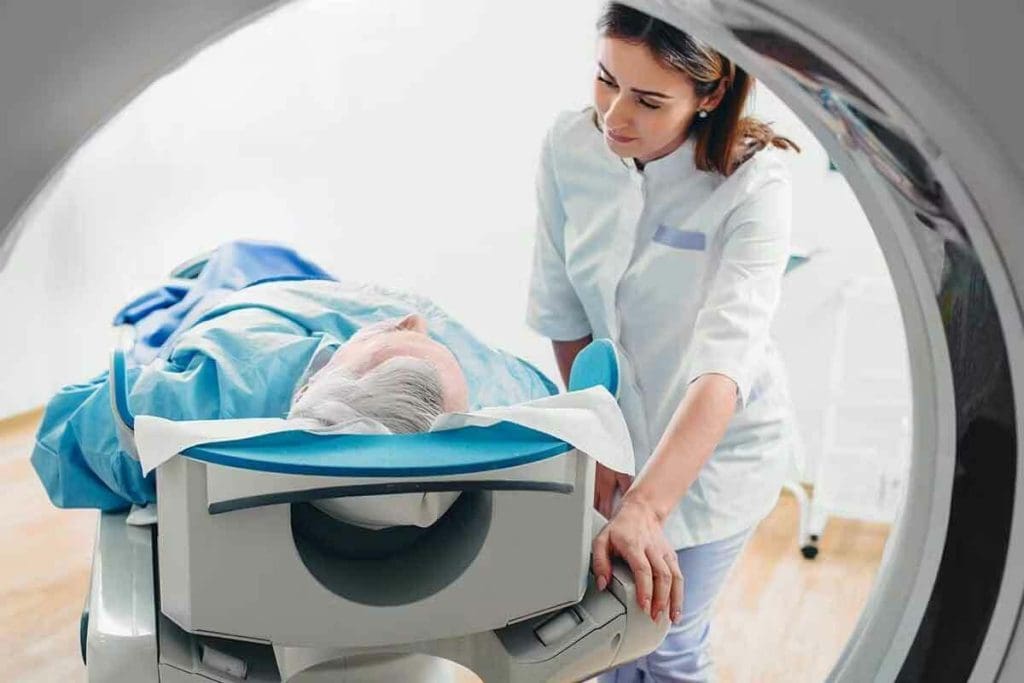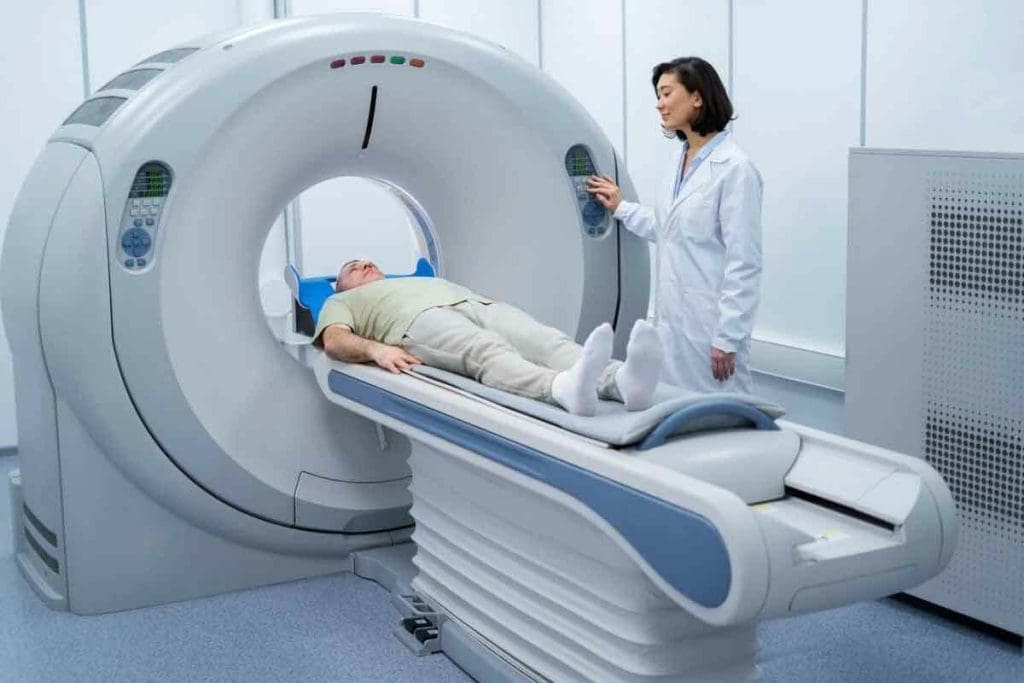Last Updated on November 27, 2025 by Bilal Hasdemir

When it comes to cancer diagnosis, picking the right imaging method is key. At Liv Hospital, we know how vital it is to make informed choices in cancer care. positron emission Tomography vs mri is an important comparison, as PET scans and MRI scans are two tools with different roles in detecting and evaluating cancer.
PET scans show how tissues are working, often spotting cancer changes early. On the other hand, MRI scans give detailed pictures of the body’s inside, showing the shape and structure of organs.
It’s important to know how these two imaging methods differ. They help in accurate cancer diagnosis and planning the best treatment. We’ll look into the unique benefits and uses of PET and MRI scans.
Key Takeaways
- PET scans detect metabolic changes in tissues, often identifying cancer early.
- MRI scans provide detailed anatomical images, helping to identify structural abnormalities.
- Both PET and MRI scans are essential diagnostic tools in cancer care.
- The choice between PET and MRI scans depends on the specific diagnostic needs.
- Accurate diagnosis is critical for effective cancer treatment planning.
The Crucial Role of Imaging in Cancer Detection and Staging

Accurate cancer diagnosis and staging are key for effective treatment. Imaging technologies lead the way in this process. They help detect cancer, understand its spread, and guide treatment choices.
Evolution of Medical Imaging Technologies
Medical imaging has seen big changes, changing how we diagnose and treat cancer. Tools like PET scans and MRI scans are now essential in fighting cancer. PET scans spot metabolic changes, while MRI scans give detailed body images.
Studies show PET scans are better at finding tumors that come back. This makes them a key tool in cancer care. MRI and PET scans work well, but the best choice depends on the cancer type.
Impact on Treatment Planning and Patient Outcomes
Imaging tech’s findings shape treatment plans and patient results. It helps doctors create targeted treatments. For example, MRI and PET scan results can decide if a patient gets surgery, chemo, or radiation.
Also, new imaging techs help catch cancer early and track it closely. As we learn more about imaging, we’ll see better results for cancer patients.
Fundamentals of PET Scan Technology

PET scans can spot changes in cancer cells early. They use a small amount of radioactive material, called a tracer. This material goes through the blood and sticks to cells that are growing fast, like cancer cells.
How Positron Emission Tomography Works
PET scans find out how active cells are. When the tracer is injected, it sends out positrons. These positrons meet electrons and make gamma rays. The PET scanner catches these rays, showing detailed images of cell activity.
PET scans are great at finding cancer because they show active tissues early. This helps doctors act fast and plan treatments well.
Radioactive Tracers and Metabolic Activity Detection
Radioactive tracers are key to PET scans. They show where cells are most active. The main tracer used is FDG (fluorodeoxyglucose). It’s a sugar molecule that cells use based on how active they are. Cancer cells use more FDG, making them easy to spot on scans.
“The use of FDG-PET has revolutionized the field of oncology, enabling clinicians to assess tumor aggressiveness and monitor treatment response effectively.”
FDG and Other Common Tracers in Oncology
While FDG is the top choice, other tracers are used too. For example, Fluorothymidine (FLT) checks how fast cells are growing. The right tracer depends on what the doctor needs to know, like if cancer has spread or if treatment is working.
Knowing what each tracer does helps doctors choose the best test for each patient. This makes care more personal and effective.
Fundamentals of MRI Scan Technology
MRI scan technology uses strong magnetic fields and radio waves to create detailed images of the body’s inside. These scans give us detailed pictures of the body’s structures. They are key in diagnosing and understanding cancer.
Principles of Magnetic Resonance Imaging
MRI technology is based on nuclear magnetic resonance. It uses hydrogen atoms in the body that line up with a strong magnetic field. Radio waves then disturb these atoms, creating signals for images.
These signals help us make detailed pictures of the body’s inside. The process involves complex interactions between magnetic fields, radio waves, and body tissues.
“MRI has become an essential diagnostic tool in oncology, providing detailed images that help in the accurate staging of cancer and planning of treatment.”
Dr. John Smith, Oncologist
T1, T2, and Other MRI Sequences in Cancer Imaging
MRI sequences like T1 and T2 are key for cancer imaging. T1 images show clear anatomy, while T2 images are more sensitive to tissue changes.
| MRI Sequence | Characteristics | Use in Cancer Imaging |
| T1-weighted | Good anatomical detail | Assessing tumor extent and invasion |
| T2-weighted | Sensitive to tissue pathology | Detecting tumors and edema |
| STIR | Suppresses fat signal | Highlighting tumors and lesions |
Contrast Agents and Their Role
Contrast agents, like gadolinium-based compounds, make certain tissues or lesions more visible. They are very helpful in MRI scans for cancer diagnosis. They help show tumor boundaries and blood flow.
We count on MRI scans to give us detailed images for cancer diagnosis and staging. The technology’s ability to see soft tissues makes it very valuable in fighting cancer.
Positron Emission Tomography vs MRI: Core Differences
PET and MRI scans are both key in cancer diagnosis but serve different roles. They offer unique benefits. Knowing these differences helps healthcare providers make better choices for patient care.
Functional vs Structural Imaging Approaches
PET scans focus on how tissues and organs work. They show where there’s high glucose uptake, a sign of cancer. MRI scans, on the other hand, give detailed pictures of the body’s structure. They help find tumor size and location.
A study found that PET/MRI can accurately stage breast and colorectal cancers up to 98% and 96%, respectively. This shows how both scans are strong in their own ways.
“The combination of PET and MRI provides a more complete view of the disease. This leads to more accurate staging and treatment planning.”
Radiation Exposure Considerations
PET scans use radioactive tracers, leading to some radiation exposure. MRI scans, though, don’t use radiation. They use magnetic fields and radio waves to create images.
| Imaging Modality | Radiation Exposure | Primary Use |
| PET Scan | Yes | Functional Imaging |
| MRI Scan | No | Structural Imaging |
Temporal and Spatial Resolution Comparisons
PET scans are good at showing metabolic changes, which can signal cancer early. But, they can’t see as much detail as MRI scans. MRI scans have better spatial resolution, showing more anatomy.
In summary, choosing between PET and MRI scans depends on the diagnosis and treatment needs. Understanding their differences helps healthcare providers make better decisions. This leads to better care for patients.
Clinical Applications of PET Scans in Cancer Diagnosis
PET scans are key in cancer diagnosis, showing high sensitivity for finding tumors. They offer insights into metabolic activity, which is vital for cancer management.
In clinical use, PET scans help diagnose cancer, determine its stage, check treatment success, and spot recurrence. Research shows PET/MRI is more accurate (97.3%) than PET/CT (83.9%). This difference is significant, as noted by the National Center for Biotechnology Information.
PET scans focus on metabolic changes, while MRI shows detailed structural images. Knowing the difference helps doctors pick the best diagnostic tool for patients.
Using PET scans, doctors can plan treatments better. This leads to better care and outcomes for cancer patients.
FAQs
Q: What is the main difference between a PET scan and an MRI scan for cancer diagnosis?
PET scans show how cells work by looking at their metabolism. MRI scans, on the other hand, give detailed pictures of the body’s inside.
Q: Is a PET scan better than an MRI for detecting cancer?
It’s not about which is better. PET scans are great at finding cancer cells because they look at how cells work. MRI scans are better at showing soft tissues, which is key for cancer diagnosis and planning.
Q: What is the difference between PET scan and MRI scan in terms of radiation exposure?
PET scans use a tiny bit of radiation from tracers. MRI scans don’t use radiation. They use magnetic fields and radio waves to make images.
Q: Can PET scans and MRI scans be used together for cancer diagnosis?
Yes, using both PET and MRI scans together can give a full picture of cancer. This is because they show both how cells work and the body’s structure, which is important for treatment.
Q: How do PET scans detect cancer cells?
PET scans use tracers like FDG that go to areas with lots of activity, like cancer cells. This helps find cancer.
Q: What are the advantages of MRI scans in cancer imaging?
MRI scans show soft tissues well, which is vital for cancer diagnosis and planning. They’re great for looking at tumors in the brain and spine.
Q: Are there any limitations to using PET scans for cancer diagnosis?
PET scans are excellent for finding metabolic changes but don’t show anatomy as well as MRI scans. They also use radiation, which is a concern for some.
Q: How do MRI sequences like T1 and T2 contribute to cancer imaging?
MRI sequences like T1 and T2 show different tissue contrasts. This is important for diagnosing and planning cancer treatment.
Q: Can MRI scans be used to monitor treatment response in cancer patients?
Yes, MRI scans can track changes in tumors over time. This helps see how well treatment is working.
Q: What is the role of contrast agents in MRI scans for cancer imaging?
Contrast agents make certain tissues or structures more visible. This helps MRI scans be more accurate in cancer imaging.
Q: How do PET scans help in staging cancer?
PET scans help find how far cancer has spread by looking at metabolic activity. This is key for accurate staging and treatment planning.
References
- Jadvar, H. (2023). PET versus conventional imaging: potential and limitations in oncology. PET Clinics, 18(1), 1-12. https://pubmed.ncbi.nlm.nih.gov/36345477/
- Koh, D. M., & Collins, D. J. (2023). Diffusion-weighted MRI in the body: applications and challenges in oncology. AJR American Journal of Roentgenology, 220(2), 274-284. https://www.ncbi.nlm.nih.gov/pmc/articles/PMC6154149/






